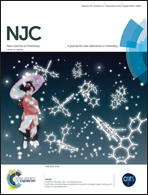Syntheses and luminescence of La1−xEux[B8O11(OH)5] and β-La1−xEuxB5O9 (0 ≤ x ≤ 0.135)†
Abstract
Luminescence studies on rare earth borates have been active for a long time. Here we performed a careful synthesis to prepare pure samples of La1−xEux[B8O11(OH)5] (0 ≤ x ≤ 0.135) using the boric acid flux method, and after evaluating its thermal behavior by thermogravimetric analysis and powder X-ray diffraction, an appropriate thermal treatment was applied to prepare anhydrous β-La1−xEuxB5O9 (810 °C, 10 h), thus allowing for the study of their Eu3+-luminescence in a relatively wide range of Eu3+-concentrations. The comparatively strong f–f transition of La1−xEux[B8O11(OH)5] in the excitation spectra suggests its potential as a red-emitting phosphor for white-light emitting diodes, which can be efficiently excited by ultraviolet-light emitting diode chips and show the strongest red emission at 622 nm. In contrast, β-La1−xEuxB5O9 shows a very intense O2− → Eu3+ CT absorption, and give strong red emissions with red/orange ratios ∼2.4. Both La1−xEux[B8O11(OH)5] and β-La1−xEuxB5O9 show no concentration quenching up to the maximal x = 0.135, which is as-expected due to their large spatial distances between rare earth cations. It is the first time to study the luminescent performance when La[B8O11(OH)5] and β-LaB5O9 were used as hosts. In addition, La0.93Eu0.07[B8O11(OH)5] was selected as a representative to study the luminescence evolution during thermal treatments.
![Graphical abstract: Syntheses and luminescence of La1−xEux[B8O11(OH)5] and β-La1−xEuxB5O9 (0 ≤ x ≤ 0.135)](/en/Image/Get?imageInfo.ImageType=GA&imageInfo.ImageIdentifier.ManuscriptID=C5NJ02091C&imageInfo.ImageIdentifier.Year=2015)

 Please wait while we load your content...
Please wait while we load your content...